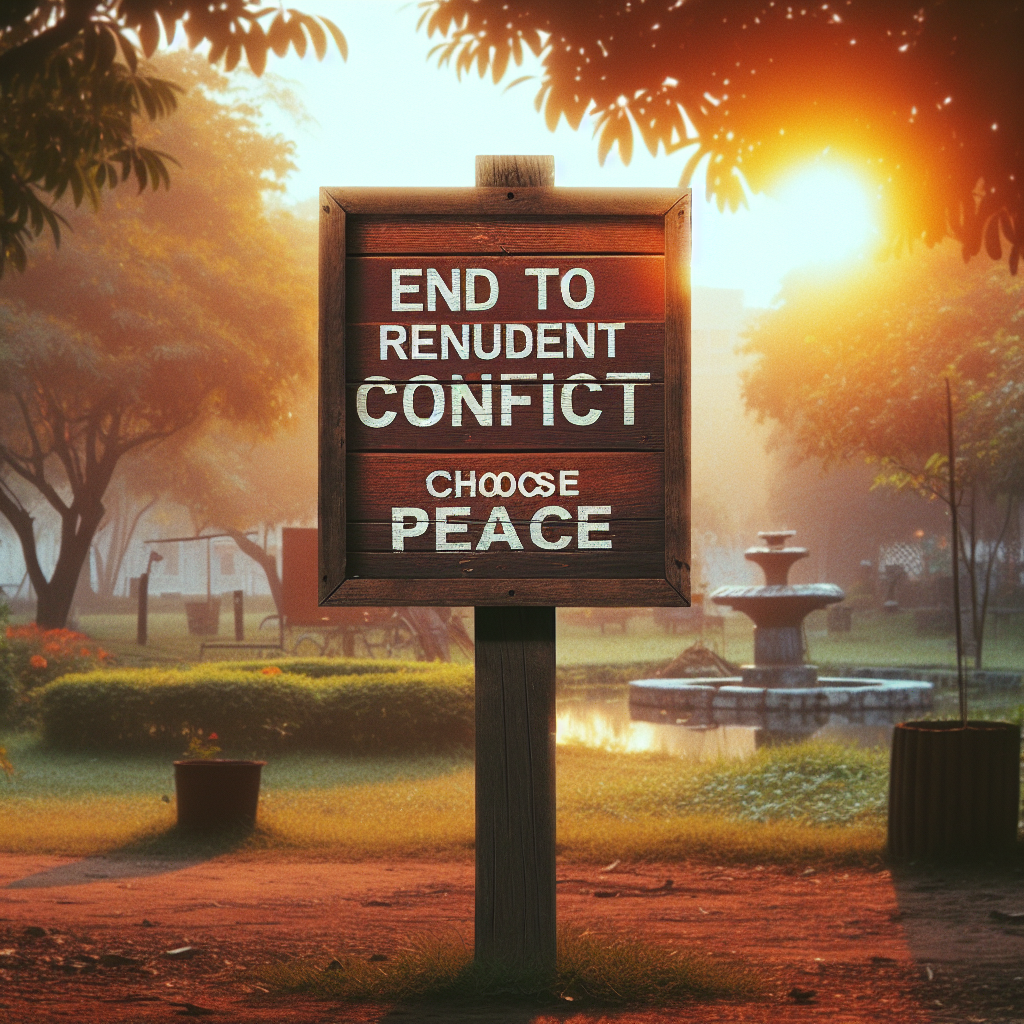How to stop fighting the same fight over and over
Recognizing the Roots of Recurrent Conflicts
Understanding Our Triggers
One of the first steps in breaking this maddening cycle is to really dive deep into what pushes our buttons. I’ve found that when I pause to identify my triggers, it not only helps me understand my emotions better but makes the conflict less about the other person and more about me. It’s essential to be honest with yourself here.
Start by keeping a journal for a week, noting down when conflicts arise and what led to them. I did this, and you won’t believe the patterns I uncovered! The same old issues kept popping up, often tied to fear or miscommunication. Recognizing these triggers is the foundation to addressing them properly.
Ultimately, acknowledging your emotional triggers is liberating. It can transform your responses from defensive reactions to thoughtful discussions. This realization isn’t painless but is a crucial step towards resolving these repeating fights.
Evaluating Your Previous Arguments
Now that you’ve recognized your triggers, it’s time to look back at your previous arguments. Seriously, take some time and revisit those moments. Ask yourself: What was truly at stake? Often, I found that the root problems weren’t what I thought they were. This reflection helps bring clarity to the situation.
It’s also helpful to discuss these reflections with the person involved. I had this conversation recently with a friend over coffee, and it was eye-opening! We spent time reflecting on past arguments and both realized that many were based on misunderstandings. Just by talking openly, we could alleviate future tensions.
Evaluating past arguments can bolster our understanding of the conflict dynamics not just for ourselves but also for the other parties involved. It’s like putting on a new set of glasses that allow you to see the full picture more clearly.
Communicating Openly About Repeat Issues
Once you’ve unpacked your triggers and evaluated past conversations, it’s time for some upfront communication. I can’t stress how important this is! Having an open dialogue about what has happened and what matters to both parties can work wonders. Be prepared to listen, too. Trust me, it’s not about winning; it’s about finding common ground.
During one of my discussions, I expressed how certain unresolved issues kept surfacing in our conversations. Surprisingly, the other person didn’t even realize it, which led to a deeper conversation about our communication styles. Being open creates a safe space for vulnerability and honesty, which is what’ll help to really resolve these ongoing fights.
Remember to frame the conversation positively; focus on solutions rather than past grievances. Together, you can brainstorm how to approach similar situations differently in the future. This open dialogue paves the way for more healthy discussions, steering clear of the same old arguments.
Setting Boundaries and Expectations
Defining Personal Boundaries
Once you’re equipped with insight from the previous steps, it’s essential to set concrete boundaries. Think of them as a safety net. When I set boundaries after grappling with cycles of conflict, I felt empowered because I knew what I would and wouldn’t tolerate. Sure, it requires assertiveness, but it builds respect on both sides.
Boundaries can be as simple as stating what you need during disagreements. For instance, I told a friend, “I need a minute to gather my thoughts before we dive into this next time.” This clarity makes sure both sides are aware of what they can expect from each other during a conflict, which can alleviate those familiar tensions.
It’s important to communicate these boundaries clearly and follow through. While you might feel awkward at first, it can create mutual respect and understanding, paving the way for empowering discussions next time conflict arises!
Managing Expectations Before Conflict Arises
Setting realistic expectations is another key factor in preventing the same fights. When I approach a situation with the mindset that it might go south, I prepare myself mentally. I remind myself that not every disagreement needs to turn into a full-on brawl. Having a cool-headed approach is a game changer!
Before engaging in any risky discussions, take a moment to visualize how you want things to go. Instead of gearing up for battle, I often remind myself, “This is a conversation, not a competition.” When I keep this in the back of my mind, the overall energy shifts significantly.
Once you and your fellow conversant are on the same page regarding expectations, you can focus on productive dialogue. And we all know the best outcomes come from conversations where everyone feels heard and respected.
Creating a Conflict Resolution Plan
Alright, time to put pen to paper and create a conflict resolution plan! This is essential to give you both an aligned approach on how to react when tensions begin to surface. I’ve done this in several friendships, and it lays down a clear path for accountability.
In my plan, I outline what we’ll both do when we feel that we’re about to repeat a familiar argument. For instance, if we know a topic tends to ignite frustration, we agreed beforehand to take a step back and engage after a cooldown period to reflect.
This proactive approach helps lighten the emotional load associated with arguments and promotes healthier exchanges. A conflict resolution plan turns potential outbursts into constructive discussions that keep you from getting trapped in the same disagreement again.
Practicing Forgiveness and Moving Forward
Letting Go of Past Resentments
Man, holding onto grudges can weigh you down. As I’ve learned, truly moving forward means practicing forgiveness—not just for the other person but for myself, too. It’s easy to ruminate on past fights, but that only feeds the cycle.
Sometimes, sharing how I felt after a conflict with the person involved helps release some of that tension. I’ve been surprised by the relief that comes from saying, “I’m ready to let go.” It’s freeing! Forgiving doesn’t mean ignoring issues; it means choosing not to carry them around forever.
Taking time to forgive can allow both parties to connect on a deeper level. You’re creating space for personal growth as well as collective healing. This lightness can dramatically change how future conflicts are handled, significantly reducing the likelihood of those nagging, repetitive fights.
Understanding That Nobody’s Perfect
We’ve all stumbled, right? I often remind myself that I’m not perfect; neither is the person I’m in conflict with. Recognizing that we’re all learning in this wild journey helps soften my stance during disagreements. Once I embraced that notion, I began to view conflicts as opportunities to strengthen relationships rather than threats.
Embodying compassion during tense times can take the form of a simple phrase: “We are both trying our best.” This statement might sound fluffy, but when I adjust my perspective and remember that we’re on this complex journey together, it sets a more supportive tone and less of a combative one.
Owning up to our imperfections doesn’t excuse bad behavior, but it opens the door for honest conversations around it. This understanding fosters a space of growth in each other, reducing the recurrence of earlier fights. It’s a powerful shift that makes navigating conflicts a bit more bearable.
Building a Healthy Foundation for Future Interactions
Finally, it’s essential to build on the lessons learned. After every conflict, I take a little time to reflect on the experiences and methods we used to resolve our issues. Building a healthy foundation means not only reinforcing the communication techniques but also celebrating the times we successfully avoided conflict.
Attending to past conflicts by reflecting on our growth helps prevent future issues while also allowing us to strengthen the bond. I love to keep it light-hearted and share the little victories along the way. Like, “Remember last month when we actually communicated and avoided that argument?” It serves as an affirmation of our growth!
So, as I look to the future, I actively seek ways to enhance our relationship by applying the insights gained from past fights. This continuous evolution creates a richer bond and makes it far less likely that we’ll be stuck in those same pesky arguments down the road.
FAQ
1. How do I recognize the triggers prompting my arguments?
Start by keeping a journal of conversations that lead to conflict. Take note of your feelings and assess the root causes. Reflection can unveil patterns identified in past disputes.
2. What should I do if my partner isn’t open to discussing conflicts?
If that’s the case, gently approach the topic and share your perspective. Encourage them to express their feelings, and emphasize how important healthy communication is for your relationship.
3. How can I set boundaries without coming off as harsh?
Communicate your boundaries kindly, focusing on how they make you feel. Ensure they come from a place of love and respect for yourself and the other person, promoting understanding.
4. Should I always forgive immediately after a conflict?
Forgiveness is a personal journey and comes in different timelines for everyone. Allow yourself to feel and process your emotions before deciding to forgive fully.
5. Can I apply these strategies in all my relationships?
Absolutely! These principles can benefit various relationships, be they friendships, family dynamics, or romantic partnerships. Adapt them according to each situation, keeping communication open.
Related Content
- How to Make Women See You as More Attractive Without Changing Anything About Your Looks
- 10 Effective Ways to Reconnect with Your Spouse in 2025: The Ultimate Guide
- How Confidence Can Transform Your Attractiveness to Women
- The Ultimate 7 Strategies to Understand What Emotionally Secure Relationships Look Like in 2025
- 10 Effective passport bros safety tips while abroad to stay secure in 2025










